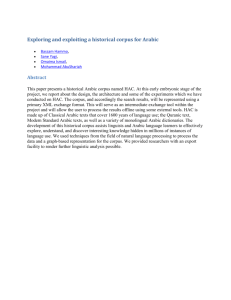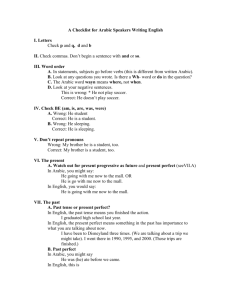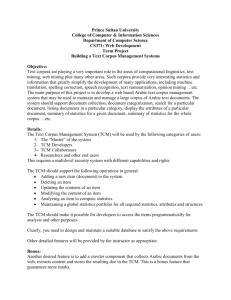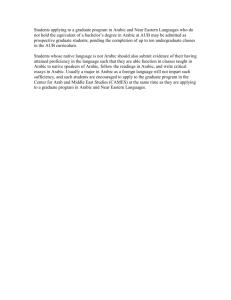Extending the corpus of contemporary Arabic
advertisement
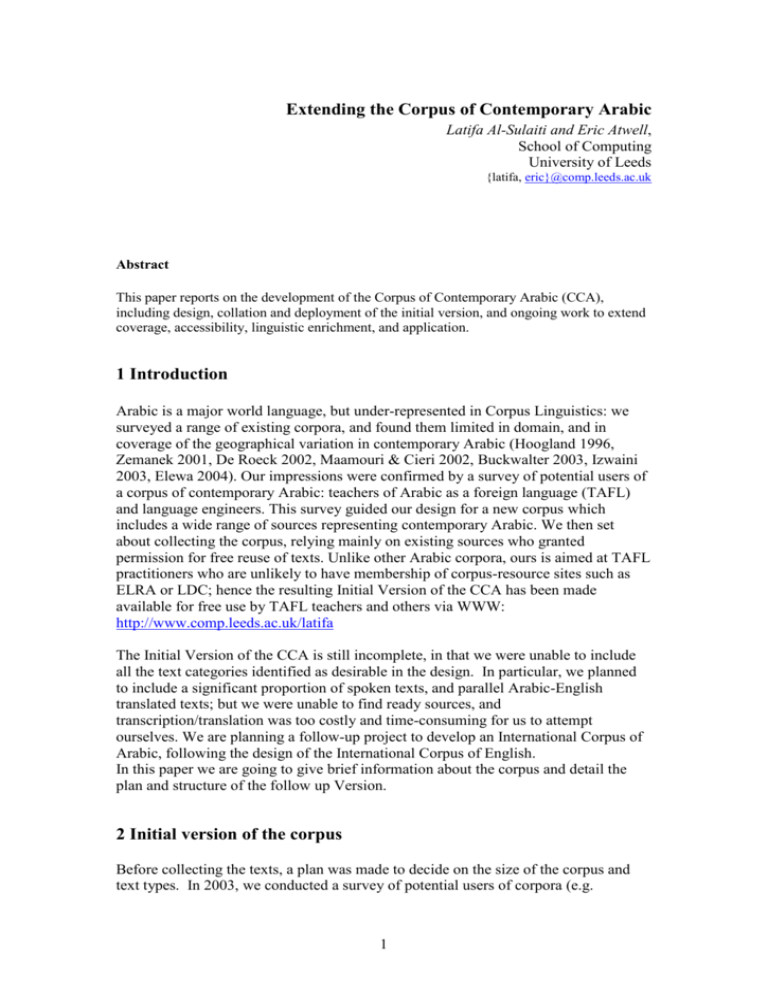
Extending the Corpus of Contemporary Arabic
Latifa Al-Sulaiti and Eric Atwell,
School of Computing
University of Leeds
{latifa, eric}@comp.leeds.ac.uk
Abstract
This paper reports on the development of the Corpus of Contemporary Arabic (CCA),
including design, collation and deployment of the initial version, and ongoing work to extend
coverage, accessibility, linguistic enrichment, and application.
1 Introduction
Arabic is a major world language, but under-represented in Corpus Linguistics: we
surveyed a range of existing corpora, and found them limited in domain, and in
coverage of the geographical variation in contemporary Arabic (Hoogland 1996,
Zemanek 2001, De Roeck 2002, Maamouri & Cieri 2002, Buckwalter 2003, Izwaini
2003, Elewa 2004). Our impressions were confirmed by a survey of potential users of
a corpus of contemporary Arabic: teachers of Arabic as a foreign language (TAFL)
and language engineers. This survey guided our design for a new corpus which
includes a wide range of sources representing contemporary Arabic. We then set
about collecting the corpus, relying mainly on existing sources who granted
permission for free reuse of texts. Unlike other Arabic corpora, ours is aimed at TAFL
practitioners who are unlikely to have membership of corpus-resource sites such as
ELRA or LDC; hence the resulting Initial Version of the CCA has been made
available for free use by TAFL teachers and others via WWW:
http://www.comp.leeds.ac.uk/latifa
The Initial Version of the CCA is still incomplete, in that we were unable to include
all the text categories identified as desirable in the design. In particular, we planned
to include a significant proportion of spoken texts, and parallel Arabic-English
translated texts; but we were unable to find ready sources, and
transcription/translation was too costly and time-consuming for us to attempt
ourselves. We are planning a follow-up project to develop an International Corpus of
Arabic, following the design of the International Corpus of English.
In this paper we are going to give brief information about the corpus and detail the
plan and structure of the follow up Version.
2 Initial version of the corpus
Before collecting the texts, a plan was made to decide on the size of the corpus and
text types. In 2003, we conducted a survey of potential users of corpora (e.g.
1
language teachers and language engineers) to give us guidance for corpus design. The
primary aim of the survey was to grade a list of texts on the scale of very useful,
useful, and not useful for their own needs. Responses showed that language teachers
selected short stories and television to be on top of the list in addition to arts subjects.
The science and technical subjects were at the end of the list. However, the language
engineers selected newspapers to be on top of the list in addition to a mixture of arts
subjects and science.
The collection of the CCA was designed to match the needs of the users. Our initial
task was to find online resources and obtain copyright permission from web site
owners. Once copyright was granted, we began our text collection. It is worth
mentioning that the content of the corpus was more controlled by the availability of
the text type on the internet and whether we were granted permission of copyright.
This affected the balance of the corpus at this stage in that we found enough material
for some text types or even more than enough but little or nothing for others.
Text collection was done manually because only those sites who had given their
consent were used. Every text was encoded with a header with the necessary external
and internal information and the files were saved as XML documents.
At the end of our 1-year project, we published an initial version of the Corpus of
Contemporary Arabic on the World Wide Web1 . The initial version of the CCA was
presented at TALC’04 in Granada (Al-Sulaiti and Atwell 2004), and used to
demonstrate portability of the XAIRA concordancer (Burnard 2004) to Arabic. So far
the CCA contains over 843,000 tokens in 416 files covering a wide range of
categories. The list included in the questionnaire contained a mixture of text types and
sources from which these text types are obtained. The sources are: newspapers,
magazines, radio, TV and web pages. Table 1 shows the text categories which are
derived from any of the sources, the number of texts in each category, and number of
words. Figure 1 shows the percentage of each source used.
Text Categories
Written
1
Short stories
2
Television
3
Education
4
Newspapers
5
Radio
6
Application forms
7
Web pages
8
Religion
9
Academic papers
10 Business letters
11 Advertisements
12 Magazines
13 Poetry
14 Formal letters
15 Entertainments
16 Autobiography
1
No. of texts
No. of words
31
Source
10
Source
Source
Source
19
n/a
111,199
5
n/a
1,147
2
73
4,014
153,459
Source
http://www.com.leeds.ac.uk/latifa/
2
45,460
n/a
25,574
n/a
n/a
17 Sociology
18 Conversation
19 Tourist/travel
20 Instruction manuals
21 Recipes
22 Geography
23 Scientific documents
24 Emails
25 Teen’s stories
26 Plays
27 Restaurant menus
28 Sports
30 Economics
31 Children’s stories
32 Memos
33 Fashion
34 Health and medicine
35 Technical documents
36 Financial documents
37 User manuals
38 Legal documents
39 Internet computer documents
40 Calls for tender
41 Patents
42 Interviews
43 Politics
Spoken
1
Education
(MSA)
2
Sports
(ESA)
3
Entertainment (colloquial)
4
Politics
(MSA)
30
85,688
61
46,093
9
4,973
45
104,795
n/a
3
29
27
8,290
67,478
21,958
32
40,480
2
12,297
24
9
58,408
46,291
2
3
1
1
1,240
1,736
1,377
1,252
Source
Table 1: Number of texts and number of words in each category
Number of Texts
350
Number of texts
300
250
200
150
100
50
M
TV
ag
az
in
e
W
eb
sit
N
ew es
sp
ap
er
s
Ra
di
o
Em
ai
l
0
Sources
Figure 1: Number of texts collected from the different sources
3
The original aim was to compile a million-word corpus. However, when the collection
phase of the project began, it became obvious to us that this target was unachievable if
we consider including a sufficient size of spoken sources and parallel Arabic-English
translations. These are not only inaccessible at this stage but they are also timeconsuming to process. Instead of filling up the million-word target with printed texts,
therefore, we decided to leave a gap for spoken and parallel Arabic-English texts, to
be filled later in a follow-up project to extend the corpus of contemporary Arabic to
Version 2.
3 Extending the corpus
Following the project of the International Corpus of English, we are planning to
develop a follow up project to extend the corpus. We will set up infrastructure and
prototype sampler corpus for the International Corpus of Arabic, an international
collaborative research programme to parallel the International Corpus of English.
Estimated person-months in the following work-packages refer to Research Fellow
(RF) and Software Engineer (SE) time; work by Investigators, Steering Panel members
and consultants is not included in these person-month estimates:
3.1 Project Management via ICA International Steering Panel
An International Steering Panel of stakeholders will establish agreed standards for text
types and categories; encoding and XML mark-up; morphological analysis,
lemmatisation and Part-of-Speech tagging; and parallel English translations. Standards
proposals will be drawn up by the project Investigators, but subject to improvement and
approval by the International Steering Panel. Membership will include Project
Investigators and Researchers Atwell, Al-Sulaiti, and Abu Shawar (Leeds); initial ICA
partners in UK university Arabic departments and Arab nations representing the main
regional variants, North African Arabic (Jamari and Soudi), Levantine Arabic (Abu
Shawar), Gulf Arabic (Abdul-Raof, Holes, Alnajem, and Almuhanna) Saudi Arabic
(Ba-Othman, Holes); and representative advisors from Corpus Linguistics and
Language Engineering: Khoja (Arabic corpus PoS-tagging), McEnery and Rayson
(Corpus Linguistics, BNC and WMATRIX) Burnard (BNC and XAIRA), Nelson
(ICE), Choukri (ELRA), Marr (OUP dictionary production and publishing), Beesley
(Xerox Arabic language research). The most important function of the International
Steering Panel will be to assure the ongoing sustainability of the project both during
and beyond its time frame.
3.2 Standards for Corpus Composition and Mark-Up
We propose to adapt the ICE standards for corpus design (Nelson 1996a) and
annotation (Nelson 1996b) for the International Corpus of Arabic. This will facilitate
comparisons between national varieties of Arabic via national ICA subcorpora, and
even comparisons between ICE and ICA subcorpora. The ICA Steering Panel will
decide whether and how the adaptation to ICA should allow for some features specific
to Arabic, such as the inclusion of religious texts, and English parallel translations.
Whereas science and business were major drivers for the internationalisation of
English, the international spread of Arabic is more tied up with religion: Arabic is the
official language of Islam, and much teaching of Arabic as a foreign language (TAFL)
is linked to religion. So, it would seem appropriate to increase the representation of
4
religious sources in the standard design, at the expense of some science and business
texts; and to include the Qur’an, the holy book at the heart of Islam, as the first text in
the ICA Sampler Corpus. Much official and scientific publication in Arab countries is
in English as well as (or instead of) Arabic; for example the first issue of the Arabic
Computing Society newsletter (ironically, published in English) entreats Arab
computing researchers to publish in Arabic as well as English. So, it would seem
appropriate to collect parallel English translations of a proportion of the ICA texts, for
use in comparative Arabic-English studies such as Machine Translation evaluation and
lexicography.
3.3 Infrastructure for Computer Supported Collaborative Work
We will provide a knowledge management environment for computer-supported
collaborative work including discussion and authoring of standards, and download of
tools for collation, mark-up, lexico-grammatical analysis, exploration and
dissemination of the International Corpus of Arabic. The Virtual Knowledge Park
(VKP) environment developed at Leeds University for Computer-Supported
Collaborative Work (CSCW) provides a comprehensive range of tools including
document management, discussion groups and video conferencing, which enable
geographically dispersed team members to share information, discuss project issues and
jointly modify team resources, if necessary in real time. The available document
management facilities allow for any electronic file to be made available to the wider
community in any format. Strict access control mechanisms and version control
provides support for managed peer review processes. The VKP can be used as a central
storage mechanism for all activities associated with the project. All resources within
the VKP (documents, discussion threads etc) can be accessed directly from other webenabled third party systems through the provision of direct URLs. Links can therefore
be built into external systems that will take users directly to resources held in the VKP.
Similarly, links to external resources can be embedded within the VKP, thus providing
users with a seamless two-way link between information held across different systems.
3.4 Standards for Arabic Morphological Analysis and Part-of-Speech Tagging
We will develop a Part-of-Speech tag-set specification analogous to that of ICE
(Greenbaum 1993), but adapted to Arabic morphosyntactic analysis, and conformant to
traditional Arab academic models of Arabic grammar. A number of morphological
analysers and PoS-taggers already exist for Arabic (see Atwell et al 2004), but
generally these are adaptations of PoS-tagging software and/or standards for English.
We are planning to develop a new Arabic PoS-tagset combining EAGLES standards for
EU languages (Leech and Wilson 1996) with grammar concepts from established
academic traditions in Arabic linguistics and TAFL. This constitutes the first draft of
the ICA PoS-tagset, to be put to the ICA Steering Panel for refinement and approval.
3.5 PoS-Tagger for the ICA
As already mentioned, a number of morphological analysers and PoS-taggers already
exist for Arabic; none of these will be fully conformant to the ICA PoS-tagset
specification, but each could provide some features. Our plan is to develop a hybrid
tagger merging the analyses of existing taggers, in the style of (van Halteren et al
1998), mapping the output features onto the agreed ICA standard tag-set.
5
3.6 Collating the ICA Sampler Corpus
We will collect and mark up a 10-million-word sampler corpus as a representative
sample of contemporary Arabic. This will involve:
Searching for and selecting Internet and other freely-available sources from
which we can derive our texts, and commissioning the recording and
transcription of spoken texts. The latter is labour-intensive, hence timeconsuming and costly, requiring a Transcription Fund for fieldwork
consultancy; so we will seek to re-use available sources, eg national/local
radio/TV broadcasts.
Selecting and organising the texts, which will include written texts, speech,
bilingual Arabic-English texts.
Obtaining letters of copyright. This will involve in the first place identifying
the owners of sources and finding the right addresses.
Encoding the texts with XML mark-up. Texts with different formats (Doc,
PDF, HTML) will be converted into a unified framework (XML format) in
which the texts will be enriched with features such as paragraphing and header
information regarding text type, author, target audience, etc, following the
agreed standards (D1).
Proofreading the texts; tasks include deleting extra and unnecessary material
from texts and checking and adjusting paragraphing markers.
3.7 PoS-tagging the ICA Sampler Corpus
The ICA Sampler Corpus will provide test data for development of the D4 PoS-tagger
program. The final version of the program will be used to automatically PoS-tag the full
ICA Sampler Corpus; output will also be proofread and manually corrected.
3.8 Tools for Exploring the ICA
As mentioned above, there is a dearth of concordancers or similar corpus exploration
tools suitable for Arabic texts. Our research software needs consist of two principal
components: text processing tools and text analysis tools. Thus for the former, there
will be a need for a lemmatiser, a tagger, and an online dictionary. As for the latter we
need a concordance program that generates a frequency list of words, or find relations
among selected words, a corpus management program that works as a search engine
that searches for a text of specific nature or an author. As far as possible we are going
to utilise existing Open-Source software resources with the intention of adapting them
to suit the special nature of Arabic. Burnard of Oxford University Computing Service
will adapt the XAIRA web-based corpus management and concordancing tool for the
British National Corpus (BNC) (Burnard 2004) to explore the Arabic texts of the ICA;
this adaptation will then be expanded to internationalization of the XAIRA client
interface, to enable delivery of the system via an entirely Arabic interface. Rayson will
adapt the WMATRIX corpus-comparison and visualization tool (Rayson 2003) to allow
exploration and comparative analysis of ICA subcorpora by linguistics researchers.
6
3.9 Analysis of lexico-grammatical variation across registers and dialects
In collaboration with International Steering Panel members we will use Arabic
concordance and corpus exploration tools to analyse lexical and grammatical variation
across the contributing dialects of Arabic in this sampler corpus.
4 Conclusion
This paper gives a brief report on the initial stage of the development of the Corpus of
Contemporary Arabic (CCA). We have shown that more spoken texts and parallel
texts are important to be included and this could be accomplished in the second stage
of development. We have also illustrated the different aspects of the procedure that
we would follow. We believe that there is a great demand for such a project for the
various benefits that obtained.
English corpus linguistics research has benefited the UK English language teaching
industry, including educational institutions and publishers of dictionaries and English
language teaching materials; similarly, we predict that the International Corpus of
Arabic will give a competitive advantage to UK educational institutions and providers
of Arabic language teaching, materials and dictionaries. Longer-term impacts of the
work to be done include:
Cultural: helping to safeguard linguistic and cultural diversity in the
information society of tomorrow by strengthening the position of Arabic and
other local dialects in linguistics and language technology;
Social-Political: Promoting cooperation between Britain and the Arab world
for the purpose of developing basic components for the multilingual
information society;
Economic: Easing the entrance requirements for British companies into the
Arab market and vice versa by providing the basis for automatic translation
tools which can be used to translate documentation and marketing material.
Currently we are investigating some European and Arabic funding sources.
7
References
Al-Sulaiti, L & Atwell, E. (2004) Designing and Developing a Corpus of
Contemporary Arabic. In Proceedings of the sixth TALC conference. Granada, Spain,
p.92.
Atwell, E. Al-Sulaiti, L. Al-Osaimi, S. & Abu-Shawar, B. (2004) A Review of Corpus
Analysis Tools. In Proceedings of JEP-TALN Arabic language processing, University
of Mohamed bin Abdullah, Fez, Morocco, 229-234.
Buckwalter,
T.
(2003)
Buckwalter
Arabic
Corpus
http://www.qamus.org/wordlist.htm. (accessed June 14th, 2005)
homepage.
Burnard, L. (2004) BNC-Baby and Xaira. In TALC 2004: In Proceedings of the Sixth
Teaching and Language Corpora conference, Granada, 84-85.
De Roeck, A. (2002) ELRA’s Al-Hayat Dataset: Text Resources in Arabic Language
Engineering. In ELRA Newsletter Vol.7 No.1. 2002.
Elewa, A. (2004) Personal communication. UMIST.
Greenbaum, S. (1993) The Tagset for the International Corpus of English, in E.
Atwell and C Souter (eds.) Corpus-based Computational Linguistics. (Amsterdam:
Rodopi), 11-24.
Hoogland, J. (1996) The use of OCR software for Arabic in order to create a text
corpus of Modern Standard Arabic for lexicographic purposes. In Proceedings of the
International Conference and Exhibition on Multi-lingual Computing,
Cambridge,1996, 2701-2716.
ICE The International Corpus of English http://www.ucl.ac.uk/english-usage/ice/
2004. (accessed June 12th , 2005)
Izwaini, S.)2003( Building specialised corpora for translation studies. In Proceedings
of the workshop on Multilingual Corpora: Linguistic Requirements and Technical
Perspectives, Lancaster University 2003, 17-25.
Khoja, S. (2003) APT: An Automatic Arabic Part-of-Speech Tagger. Ph.D. thesis,
Lancaster University.
8
Leech, G. and Wilson, A. (1996) EAGLES Recommendations for the Morphosyntactic
Annotation of Corpora. EAGLES-Guidelines EAG--TCWG--MAC/R. Final version
of 3.1996. EAGLES, Istituto di Linguistica Computazionale, Pisa.
Nelson, G. (1996a) The Design of the Corpus. In Greenbaum, S (ed.) Comparing
English Worldwide: The International Corpus of English (Oxford: Clarendon Press),
27-35.
Nelson, G. (1996b) Markup Systems. In S. Greenbaum (ed.) Comparing English
Worldwide: The International Corpus of English. (Oxford: Clarendon Press), 36-53.
Maamouri, M. & Cieri, C. (2002) Resources for Arabic Natural Language Processing
at the linguistic Data Consortium. In Proceedings of the International Symposium on:
The Processing of Arabic, Tunisia, 2002, 125-146.
Mili, A. (2003) Teaching (Computer) Sciences in Arabic. In Arabic Computer Society
Newsletter Vol.1. Available on-line from http://www.tsts.org/mos/content/view/10/2/
(accessed June 13th, 2005)
Rayson, P. (2003) Matrix: A statistical method and software tool for linguistic
analysis through corpus comparison. Ph.D. thesis, Lancaster University.
Rayson, P., and Garside, R. (1998) The CLAWS Web Tagger. ICAME Journal Vol
22, 121-123.
van Halteren et al. (1998) Improving Data Driven Wordclass Tagging by System
Combination. In COLING-ACL’98, Canada, 491-497.
Zemanek, P. (2001) Clara (Corpus Linguae Arabicae): An Overview. In Proceedings
of ACL/EACL 2001 Workshop on Arabic Language Processing: Status and Prospects.
Available on-line from http://www.elsnet.org/arabic2001/zemanek.pdf (accessed June
13th, 2005)
9
